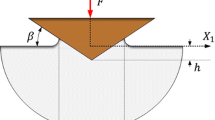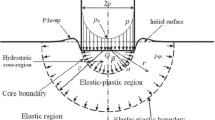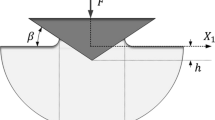Abstract
We report on the difficulties of extracting plastic parameters from constitutive equations derived by instrumented indentation tests on hard and stiff materials at shallow depths of penetration. As a general rule, we refer here to materials with an elastic stiffness more than 10 % of that of the indenter and a yield strain higher than 1 %, as well as to penetration depths less than ∼ 5 times the characteristic tip defect length of the indenter. We experimentally tested such a material (an amorphous alloy) by nanoindentation. To describe the mechanical response of the test, namely the force-displacement curve, it is necessary to consider the combined effects of indenter tip imperfections and indenter deformability. For this purpose, an identification procedure has been carried out by performing numerical simulations (using Finite Element Analysis) with constitutive equations that are known to satisfactorily describe the behaviour of the tested material. We propose a straightforward procedure to address indenter tip imperfection and deformability, which consists of firstly taking account of a deformable indenter in the numerical simulations. This procedure also involves modifying the experimental curve by considering a truncated length to create artificially the material’s response to a perfectly sharp indentation. The truncated length is determined directly from the loading part of the force-displacement curve. We also show that ignoring one or both of these issues results in large errors in the plastic parameters extracted from the data.






Similar content being viewed by others
Abbreviations
- E :
-
Young’s modulus
- ν :
-
Poisson’s ratio
- Y c :
-
Compressive yield strength
- \({\epsilon _{y}^{c}}\) :
-
Compressive yield strain
- φ :
-
Friction angle (Drucker-Prager yield criterion)
- P :
-
Indentation force
- δ :
-
Indentation depth
- C :
-
Indentation loading pre-factor
- Δδ :
-
Indenter truncated length
- R :
-
Indenter tip radius
- β :
-
Indenter equivalent complementary angle
- \(\mathcal {L}\) :
-
Residual of the identification procedure
References
Fischer-Cripps AC (2006) Introduction to Contact MEchanics. Mechanical Engineering Series, Berlin Heidelberg: Springer Berlin Heidelberg
Oliver W, Pharr G (1992) An improved technique for determining hardness and elastic modulus using load and displacement sensing indentation experiments. J Mater Res 7:1564–1583
Andrade-Campos A, Thuillier S, Pilvin P, Teixeira-Dias F (2007) On the determination of material parameters for internal variable thermoelastic-viscoplastic constitutive models. Int J Plast 23(8):1349–1379
Fischer-Cripps AC (2011) Nanoindentation. Springer, Berlin, Heidelberg
Giannakopoulos A, Suresh S (1999) Determination of elastoplastic properties by instrumented sharp indentation, vol 40
Dao M, Chollacoop N, Van Vliet KJ, Venkatesh TA, Suresh S (2001) Computational modeling of the forward and reverse problems in instrumented sharp indentation. Acta Mater 49(19):3899–3918
Casals O, Alcalá J (2005) The duality in mechanical property extractions from Vickers and Berkovich instrumented indentation experiments. Acta Mater 53:3545–3561
Lee J, Lee C, Kim B (2009) Reverse analysis of nano-indentation using different representative strains and residual indentation profiles. Mater Des 30:3395–3404
Warren AW, Guo YB (2006) Machined surface properties determined by nanoindentation: Experimental and FEA studies on the effects of surface integrity and tip geometry. Surf Coatings Technol 201(1-2):423–433
Oliver W, Pharr G (2004) Measurement of hardness and elastic modulus by instrumented indentation: Advances in understanding and refinements to methodology, vol 19
Hochstetter G, Jimenez A, Loubet J (2006) Strain-rate effects on hardness of glassy polymers in the nanoscale range. Comparison between quasi-static and continuous stiffness measurements. J Macromol Sci part B 38(5-6):681– 692
Poon B, Rittel D, Ravichandran G (2008) An analysis of nanoindentation in elasto-plastic solids. Int J Solids Struct 45:6399– 6415
Poon B, Rittel D, Ravichandran G (2008) An analysis of nanoindentation in linearly elastic solids. Int J Solids Struct 45(24):6018–6033
Wang TH, Fang TH, Lin YC (2007) A numerical study of factors affecting the characterization of nanoindentation on silicon. Mater Sci Eng A 447(1-2):244–253
Keryvin V, Vu X, Hoang V, Shen J (2010) On the deformation morphology of bulk metallic glasses underneath a Vickers indentation. J Alloys Compd 504:S41–S44
Keryvin V (2008) Indentation as a probe for pressure sensitivity of metallic glasses. J Phys Condens Matter 20:114119
Shen J, Chen Q, Sun J, Fan H, Wang G (2005) Exceptionally high glass-forming ability of an FeCoCrMoCBY alloy. Appl Phys Lett 86(15):151907
Keryvin V, Hoang VH, Shen J (2009) Hardness, toughness, brittleness and cracking systems of an iron-based bulk metallic glass by indentation. Intermetallics 17(4):211–217
VanLandingham MR, Juliano TF, Hagon MJ (2005) Measuring tip shape for instrumented indentation using atomic force microscopy. Meas Sci Technol 16(11):2173–2185
Charleux L, Keryvin V, Bizet L (2015) abapy: Abapy_v1.0
Chen W-F, Han D-J (2007) Plasticity for Structural Engineers. J. Ross Publishing Classics, Florida, USA
Donovan PE (1989) Plastic flow and fracture of Pd40Ni40P20 metallic glass under an indentor. J Mater Sci 24:523–535
Patnaik MNM, Narasimhan R, Ramamurty U (2004) Spherical indentation response of metallic glasses. Acta Mater 52(11):3335–3345
Keryvin V, Crosnier R, Laniel R, Hoang VH, Sangleboeuf J-C (2008) Indentation and scratching mechanisms of a ZrCuAlNi bulk metallic glass. J Phys D Appl Phys 41:074029
Brest J, Keryvin V, Longére P, Yokoyama Y (2014) Insight into plasticity mechanisms in metallic glasses by means of a Brazilian test and numerical simulation. J Alloys Compd 586:S236–S241
Cheng YT, Cheng CM (2004) Scaling, dimensional analysis, and indentation measurements. Mater Sci Eng R Reports 44(4-5):91–150
Tabor D (1956) The physical meaning of indentation and scratch hardness. Br J Appl Phys 7(5):159
Qu RT, Liu ZQ, Wang RF, Zhang ZF (2015) Yield strength and yield strain of metallic glasses and their correlations with glass transition temperature. J Alloys Compd 637:44–54
Keryvin V, Eswar Prasad K, Gueguen Y, Sanglebæuf J-C, Ramamurty U (2008) Temperature dependence of mechanical properties and pressure sensitivity in metallic glasses below glass transition. Philos Mag 88:1773–1790
Gadelrab K, Bonilla F, Chiesa M (2012) Densification modeling of fused silica under nanoindentation. J Non Cryst Solids 358:392–398
Acknowledgments
We acknowledge financial support from the State-Region Plan Contract PRIN2TAN programme for acquisition of the Hysitron nanoindentation apparatus. We would like to thank Prof. Jun Shen (Harbin Institute of Technology, China) for providing the samples, Dr. J.-P. Guin (CNRS, France) for the AFM measurements and Prof. P. Pilvin for advice on the identification procedure. Dr M.S.N. Carpenter post-edited the English style and grammar.
Author information
Authors and Affiliations
Corresponding author
Rights and permissions
About this article
Cite this article
Keryvin, V., Charleux, L., Bernard, C. et al. The Influence of Indenter Tip Imperfection and Deformability on Analysing Instrumented Indentation Tests at Shallow Depths of Penetration on Stiff and Hard Materials. Exp Mech 57, 1107–1113 (2017). https://doi.org/10.1007/s11340-017-0267-1
Received:
Accepted:
Published:
Issue Date:
DOI: https://doi.org/10.1007/s11340-017-0267-1




